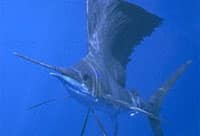
Boyce Sailfishing 200
“Right long, right long…he’s all over it!” The captain screams to the anglers below. Down in the cockpit, all the anglers can see is the tip of the fish’s “hooter” and the sloping peak of its dorsal fin as the sailfish train its eyes on its quarry and attacks at will. With fly rod in hand, and 40 feet of 12-weight line rapidly pulled out onto the deck, the anxious angler who’s up awaits the opportune time to lay the fly out for a perfect presentation. All the while, no one on that boat can truly comprehend what that fish is doing in its own world to capture what it thinks is an easy lunch.
Cut! Stop the action at that frame. This is where the ultimate thrill comes into play for me, and adrenaline races through my veins in a split second. It’s at this moment I enter that fish’s world to get an up-close and personal look at this magnificent creature’s swimming ability and to observe just how he approaches the object of his curiosity. I’ve done this before many times, but never with fly-fishermen.
OK, roll tape again. The angler still has that fly rod in hand, and the pink popper tied to the tip of the leader is ready for its quick flight into the strike zone. But this fly is different — it has no stinger ? that’s right, no hook at all. The fly-fisherman is going to present that pile of feathers in a manner that will hopefully allow me to get an underwater photograph of the exact moment the sailfish eats that fly. Not a simple task, but a ballet played out several times over our three-day journey to the richest sailfish grounds in the Pacific — Guatemala. Lodge owner Tim Choate was kind enough to provide the opportunity at the Fins ‘n Feathers Resort and Capt. Chris “Kiwi” Van Leeuwen was the man to put us on the bite. The anglers for this trip were some of the best I’ve worked with — Scott Leon, Cam Sigler and his son Cam Sigler Jr., and Darryl Seaton.
The whole concept of the bait-and-switch is perfect for what we want to accomplish here. The mates teased the fish right in tight to the stern, and the angler cast the fly to keep its interest as I slipped underwater for a quick close encounter and to capture the fish’s behavior on film. Sails are often jet-black in color when they come into this phase of the chase, perhaps to appear more robust and intimidating to their prey, by making their presence known immediately. A fish this size is surely not going to sneak up on its prey in open water. The typically folded-and-tucked-away feathery pelvic fins suddenly pop out as if from nowhere to alter its profile even more, again making the sailfish appear larger than ever to its forage. At this point, sometimes they just “pile on” the fly as though nothing could keep it from its destiny. Other times, through selective brain processes or from inquisitive apprehension, the sailfish doesn’t quite “feel the love” enough to strike. One thing is for certain, they like their prey moving, not still. The instinct for a prey species is to evade capture, and that’s what the sailfish is expecting to head off at the pass.
While underwater with these fish, you begin to feel the beauty of their design: They can easily turn on a dime and can accelerate from 0 to 50 mph while retracting their giant dorsal fins as quickly as you can blink. This enables the fish to attain jetlike speed in an instant. Even so, their huge eyes are always trained on their subject, and to watch it looking around and at you is a pure rush. At that instant you get a sense of what it perceives. Sometimes they see me and “bugger off” for the horizon; other times they ignore me and remain focused on their feeding. A sailfish rarely if ever truly utilizes its bill as a stunning device to enhance feeding, instead using it ever so skillfully to poke bait out of a school so it can eat the bait when it’s outside the security of the ball. The purest form of a mind game comes when the sailfish instantly turns its black cloak into a lit-up neon clown suit, revealing the iridescent vertical barring and brilliant bluish hues on its bill. No one is sure why it does this, but it could be to further confuse its dinner or maybe simply because the excitement produces a neuronal reaction in its brain, “turning on” the melanophores in its skin.
One thing is for certain during these close encounters: You will come back into the boat with a newfound respect for this pelagic predator, and you’ll take the memories of the experience to the end of your days.
| To learn more about William Boyce and view his photography, please visit his site at:www.boyceimage.com |









